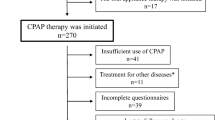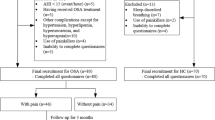Abstract
Purpose
The aim of the study was to asses quality of life and symptoms of obstructive sleep apnea syndrome (OSAS) patients after adhering to 6 months of continuous positive airway pressure (CPAP) treatment.
Methods
A group of 50 patients (41 men and 9 women) were diagnosed by polysomnography and treated with CPAP therapy for 6 months. Their symptoms and health-related quality of life were assessed by administering a validated and translated version of the sleep apnea quality of life index (SAQLI). Sleepiness was measured using the Epworth Sleepiness Scale (ESS) and through electronic monitoring of CPAP usage per night of sleep.
Results
Mean CPAP usage was 4.5 ± 0.5 h per night. Comparisons between quality of life indexes before and after CPAP treatment showed an improvement in the total SAQLI score (3.8 ± 0.9 vs. 5.8 ± 0.8 after CPAP, p < 0.01), in daily functioning (4.2 ± 1.4 vs. 6.0 ± 0.9, p < 0.01), social interactions (4.8 ± 1.3 vs.6.3 ± 0.7, p < 0.01), emotional functioning (4.4 ± 1.4 vs. 5.7 ± 1.0, p < 0.01), symptoms (1.6 ± 0.8 vs. 5.8 ± 1.2, p < 0.01), and in the ESS (13.7 ± 6.5 vs. 3.9 ± 3.8, p < 0.01). Regarding the patients’ symptoms, improvement was noticed for “sleepiness while watching a spectacle” (96%), “reading” (95%), “carrying on a conversation” (95%), “driving” (92.9%), “restless sleep” (87.8%), and “urinating more than once per night” (84.8%). Smaller improvements were observed for the reported “dry mouth–throat upon awakening” (36.1%),“excessive fatigue” (54.5%), and “decreased energy” (55.3%).
Conclusion
We conclude that OSAS patients who adhere to nighttime CPAP therapy show significant improvement of their quality of life, daytime sleepiness, and other symptoms after 6 months of treatment with CPAP.
Similar content being viewed by others
References
Qureshi A, Ballard RD (2003) Current reviews of allergy and clinical immunology of obstructive sleep apnea syndrome. J Allergy Clin Immunol 112(4):643–651
Akashiba T, Kawahara S, Akahoshi T, Omori C, Osamu S, MajimaT HT (2002) Relationship between quality of life and mood or depression in patients with severe obstructive sleep apnea syndrome. Chest 122:861–865
Melamed S, Oksenberg A (2002) Excessive daytime sleepiness and risk of occupational injuries in non shift daytime workers. Sleep 25:315–322
Lioberes P, Levy C, Descals D, Sampol G, Roca A, Sagales T, la Calzada D (2000) Self reported sleepiness while driving as a risk factor for traffic accidents in patients with OSAS and in non-apnoeic snorers. Respir Med 94:971–976
Lioberes P, Marti S, Sampol G, Roca A, Sagales T, Munoz X, Ferrer M (2004) Predictive factors of quality of life improvement and continuous positive airway pressure use in patients with sleep apnea hypopnea syndrome: study at 1 year. Chest 126:1241–1247
Zozula R, Rosen R (2001) Compliance with continuous positive airway pressure therapy: assessing and improving treatment outcomes. Curr Opin Pulm Med 7:391–398
Reeves-Hoche MK, Meck R, Zwillich CW (1994) Nasal CPAP: an objective evaluation of patient compliance. Am J Respir Crit Care Med 149(1):149–154
Sanner BM, Klewer J, Trumm A, Randerath W, Kreuzer I, Zidek W (2000) Long-term treatment with continuous positive airway pressure improves quality of life in obstructive sleep apnea syndrome. Eur Respir J 16:118–122
Pichel F, Zamarron C, Magan F, del Campo F, Alvarez-Sala R, Suarez JR (2004) Health related quality of life in patients with obstructive sleep apnea: effects of long-term positive airway pressure treatment. Respir Med 98:968–976
Flemons WW, Reimer MA (2000) The Calgary sleep apnea quality of life index (manual). The University of Calgary, Alberta, Canada
Flemons WW, Reimer MA (1998) Development of a disease specific health related quality of life questionnaire for sleep apnea. Am J Respir Crit Care Med 158:494–503
Skomto R, Kryger M (1999) Clinical presentations of OSAS. Prog Cardiovasc Dis 5:331–340
Kribbs NB, Pack AI, Kline LR, Smith PL, Schwartz AR, Schubert NM, Redline S, Henry JN, Getsy JE, Dinges DF (1993) Objective measurement of patterns of nasal CPAP use by patients with obstructive sleep apnea. Am Rev Respir Dis 147:887–895
Monasterio C, Vidal S, Duran J, Ferrer M, Carmona C, Barbé F, Mayos M, Gonzalez-Mangado N, Juncadella M, Navarro A, Barreira R, Capote F, Mayoralas LR, Peces-Barba G, Alonso J, Montserrat JM (2001) Effectiveness of continuous positive airway pressure in mild sleep apnea–hypopnea syndrome. Am J Respir Crit Care Med 164:939–943
Redline S, Strauss ME, Adams N, Winters M, Roebuck T, Spry K, Rosenberg C, Adams K (1997) Neuropsychological function in mild sleep disordered breathing. Sleep 20:160–167
Gall R, Isaac L, Kriger M (1993) Quality of life in mild obstructive sleep apnea. Sleep 16:S59–S61
Teran-Santos J, Jimenez-Gomez A, Cordero-Guevara J (1999) The association between sleep apnea and the risk of traffic accidents. N Engl J Med 340:847–851
Young T, Pepperd P, Palta M, Mae K, Finn L, Morgan B, Skartrud J (1997) Population-based study of sleep disordered breathing as a risk factor for hypertension. Arch Intern Med 157:1746–1752
Ronald D, Chervin MD (2000) Sleepiness, fatigue, tiredeness and lack of energy in obstructive sleep apnea. Chest 118:372–379
Engelman HM, Martin SE, Deary IJ, Douglas NJ (1997) Effect of CPAP therapy on daytime function in patients with mild sleep apnea/hypopnea syndrome. Thorax 52:114–119
Collard P, Pieters T, Aubert G, Delguste P, Rodenstein D (1997) Compliance with nasal CPAP in obstructive sleep apnea patients. Sleep Med Rev 1:33–44
Engelman HM, Martin SE, Douglas NJ (1994) Compliance with CPAP therapy in patients with the sleep apnea/hypopnea syndrome. Thorax 49:263–266
Hui DS, Choy DK, Lu TS, Ko FW, Wong KK, Chan JK, Lai CK (2001) Determinants of continuous positive airway ressure in agroup of Chinese patients with obstructive sleep apnea. Chest 120:170–176
Sin DD, Mayers I, Man GCW, Ghahary A and Pawluk L (2003) Can continuous positive airway pressure therapy improve the general health status of patients with obstructive sleep apnea?: a clinical effectiveness study. Chest 112(5):1679–1685
Engelman HM, Kingshott RN, Wraith PK, Mackay TW, Deary IJ, Douglas NJ (1999) Randomized placebo-controlled crossover trial of continuous positive airway pressure for mild sleep apnea/hypopnea syndrome. Am J Respir Crit Care Med 159:461–467
Barnes M, Houston D, Worsnop CJ, Neill AM, Mykytyn IJ, Kay A, Trinder J, Saunders NA, Mc Evoy D, Pierce R (2002) A randomized controlled trial of continuous positive airway pressure in mild obstructive sleep apnea. Am J Respir Crit Care Med 165:773–780
Boudewyns A, Willemen M, Wagemans M, De Cock W, De Backer W, Van de Heyhing P (1996) Improvement of the Epworth Sleepiness Score after long term CPAP or BiPAP treatment in sleep apnea patients. Sleep 25:214–220
Ryan S, Doherty LS, Nolan GM, Mc Nicholas WT (2009) Effects of heated humidification and topical steroids on compliance, nasal symptoms, and quality of life in patients with obstructive sleep apnea syndrome using nasal continuous positive airway pressure. J Clin Sleep Med 5:422–427
Wiegand DM, Hanowski RJ, McDonald SE (2009) Commercial drivers’ health: a naturalistic study of body mass index, fatigue and involvement in safety-critical events. Traffic Inj Prev 10:573–579
Redenius R, Murphy C, O’Neill E, Al-Hamwi M, Zallek SN (2008) Does CPAP lead to change in BMI? J Clin Sleep Med 210–211
Wysocka E, Cofta S, Cymetys M, Gozdzik J, Torlinski L, Batura-Gabryel H (2008) The impact of the sleep apnea syndrome on oxidant-antioxidant balance in the blood of overweight and obese patients. J Physiol Pharmacol 59:761–769
Randerath W, Bauer M, Blau A, Fietze I, Galetke W, Hein H, Maurer JT, Orth M, Rasche K, Ruhle KH, Sanner F, Stuck BA, Verse T (2007) Are there alternative therapeutical options other than CPAP in the treatment of the obstructive sleep apnea syndrome? Pneumologie 61:458–466
Strobel RJ, Rosen RC (1996) Obesity and weight loss in obstructive sleep apnea: a critical review. Sleep 19:104–115
Acknowledgments
This project was partially supported by the HEART project (Hellenic Action for Research against Tobacco) by the Behrakis Foundation to the Smoking and Lung Cancer Research Center of the Hellenic Cancer Society. The authors would like to thank Prof. Gregory Connolly for his support and participation through the HEART Study.
Conflict of interest
None to declare.
Author information
Authors and Affiliations
Corresponding author
Additional information
Conference presentations
Part of this work has been presented in the 19th Congress of the European Sleep Research Society (ESRS), Glasgow, 9–13 September2008 and also in the CHEST Conference, Chicago, Illinois, 20–25 October 2007.
Rights and permissions
About this article
Cite this article
Avlonitou, E., Kapsimalis, F., Varouchakis, G. et al. Adherence to CPAP therapy improves quality of life and reduces symptoms among obstructive sleep apnea syndrome patients. Sleep Breath 16, 563–569 (2012). https://doi.org/10.1007/s11325-011-0543-8
Received:
Revised:
Accepted:
Published:
Issue Date:
DOI: https://doi.org/10.1007/s11325-011-0543-8




